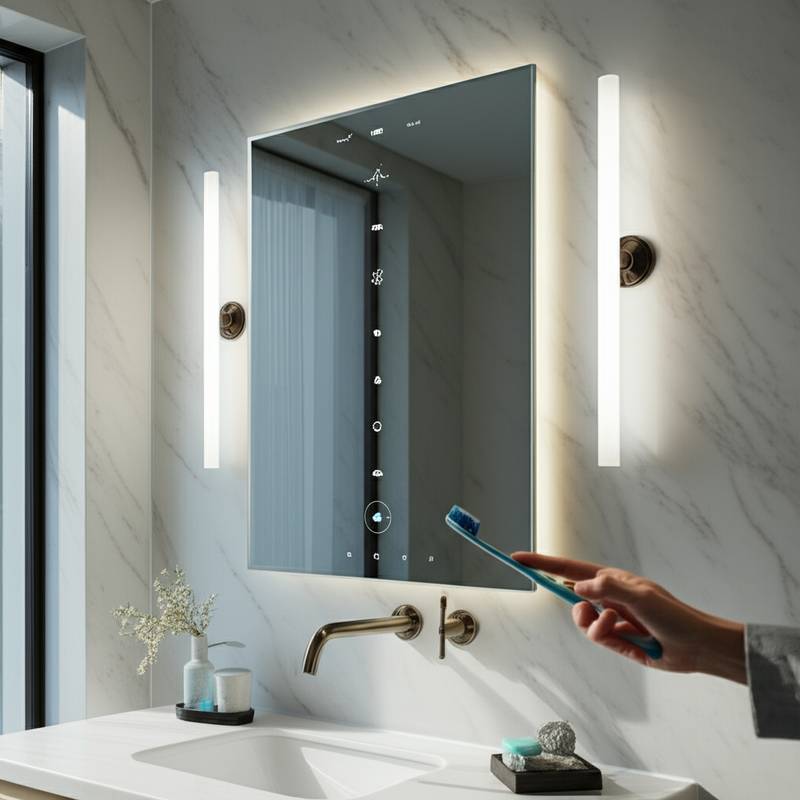Smart Mirrors Track Health During Morning Routines
Smart homes continue to advance, with bathrooms emerging as key areas for technological integration. Traditional morning activities now incorporate intelligent features that enhance well-being. Leading this trend are smart mirrors equipped to monitor and analyze health metrics while users brush their teeth. These devices extend beyond basic reflection to serve as embedded health tools, utilizing sensors, imaging technology, and artificial intelligence to deliver insights during routine moments.
Understanding the Core Technology
A smart mirror resembles a standard bathroom fixture yet conceals advanced components such as high-resolution cameras, infrared sensors, and processing algorithms behind its surface. These elements capture details like facial color variations, eye appearance, and skin texture to identify potential health signals. Certain models employ thermal imaging for measuring heart rate variability or oxygen saturation, and they often connect to complementary devices like electric toothbrushes for comprehensive data collection.
This approach proves valuable by embedding monitoring into established habits, reducing the need for separate health appointments. Early detection of subtle changes enables users to address concerns promptly, supporting long-term preventive care.
Seamless Health Analysis in Action
Picture starting your day with tooth brushing as the mirror evaluates hydration through skin analysis or detects fatigue via under-eye puffiness. Variations in complexion may indicate fluid levels, while integrated oral sensors assess brushing efficiency and gum vitality.
Brands such as HiMirror and CareOS lead with features for skin evaluation, including blemish tracking and personalized care advice. Emerging designs incorporate heart monitoring via pulse detection from facial blood flow and breathing assessments through temperature gradients. Such functionality positions the mirror as an interactive health interface, delivering immediate, tailored recommendations.
Integrating Wellness into Daily Rituals
Morning habits influence overall productivity and mood. Smart mirrors facilitate effortless health oversight by activating during these periods, eliminating the need for additional tools or applications. Visual cues appear directly on the display, aligning with preferences for unobtrusive tracking.
Market research highlights demand for automated systems that operate in the background. These mirrors align with that shift, collecting metrics during natural activities to provide insights without disrupting schedules.
Making Data Practical and Accessible
Effective health information requires simplicity and relevance. Smart mirrors display results through intuitive graphics, such as overall vitality indices or straightforward alerts like suggestions to increase water intake based on dryness indicators. Devices also propose adjustments, including enhanced rest for observed stress markers.
Synchronization with mobile applications or secure platforms enables longitudinal tracking of patterns in vital signs or skin metrics. This connectivity enriches existing setups with wearables or scales, forming a unified health network.
Addressing Privacy in Health Tech
Biometric collection demands robust safeguards. Manufacturers prioritize on-device processing to minimize external data transmission, with options for user-defined activation and local storage. Clear policies on data usage build essential confidence.
Experts forecast that privacy-centric innovations will drive market leadership. Brands transparent about security measures attract users seeking reliable, non-intrusive solutions.
Expanding Applications Across Settings
Smart mirrors find primary use in personal spaces, yet their versatility spans broader contexts. Retail environments test them for shade-matching in cosmetics, while gyms explore posture analysis during workouts. Medical facilities evaluate their role in patient monitoring for recovery indicators.
Advancements in compact sensors promise wider adoption, from automotive rearview integrations to commercial fitting areas. This evolution underscores the adaptability of reflective diagnostics in diverse sectors.
Scientific Foundations of Mirror-Based Monitoring
At the heart of these devices lies sophisticated interpretation of visual and physiological signals. Imaging systems detect blood flow shifts in the face to derive heart rate or oxygenation data. Algorithms benchmark against personal norms to spot deviations linked to exhaustion, tension, or emerging conditions.
Studies illustrate correlations between facial heat patterns and breathing efficiency. Combined with audio inputs from nearby devices, these systems gauge respiratory health or congestion risks. Future developments may include forecasting capabilities to preempt health declines.
Embracing Proactive Home Wellness
Smart mirrors signify a move toward responsive living spaces that actively contribute to user health. They complement wearables by transforming static areas into dynamic support systems. The bathroom evolves from a utilitarian zone into a center for informed self-management.
For those with demanding schedules, this integration delivers subtle guidance without added effort. Reflections become opportunities for deeper bodily awareness, fostering sustained well-being through consistent, embedded monitoring.
Steps to Adopt Smart Mirror Technology
To incorporate this innovation, evaluate options featuring robust sensors and seamless integrations. Prioritize displays with high visibility and strong privacy protocols, ensuring compatibility with current health tools. Combining a mirror with a connected toothbrush establishes an efficient monitoring hub.
Available models already realize this vision, blending futurism with practicality. Consider how your next mirror glance could reveal more about your health than ever before.
